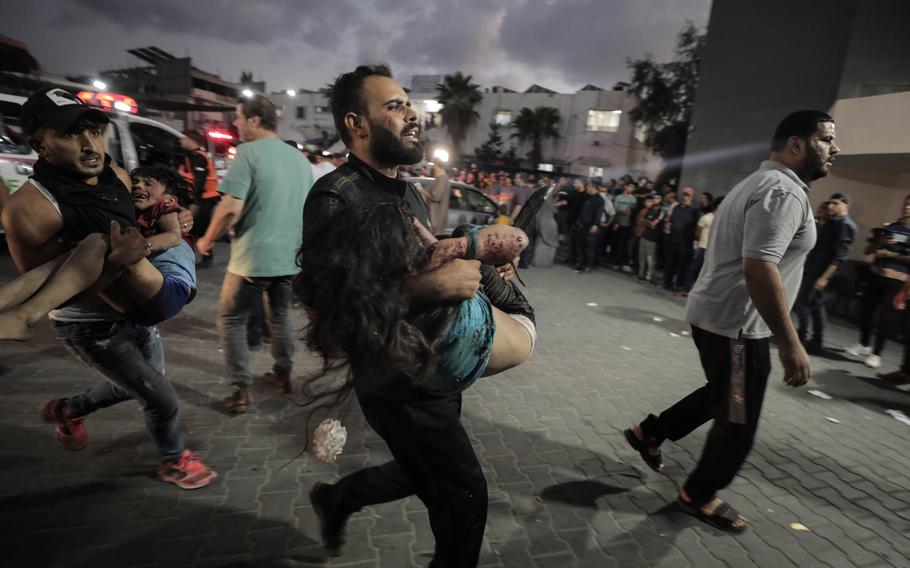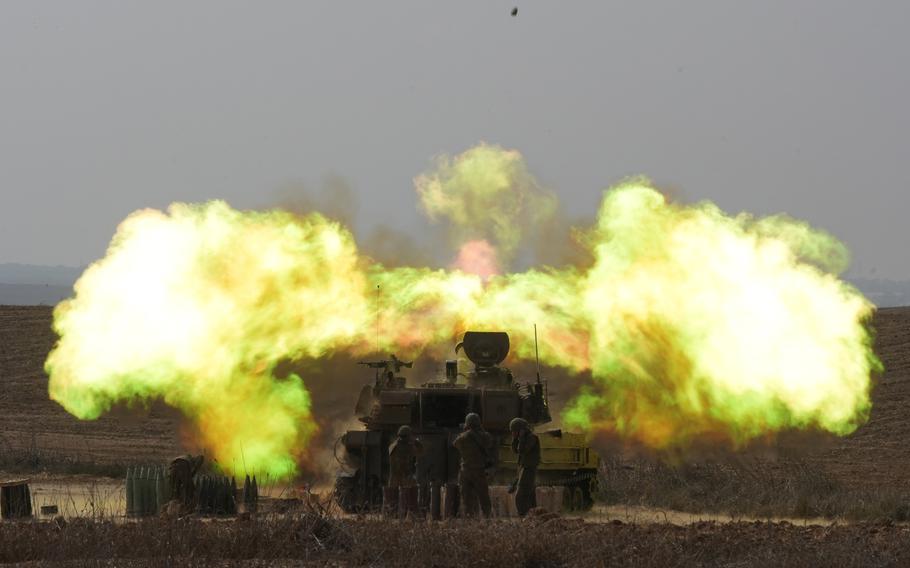Middle East
Israel says it will end Hamas rule in Gaza as casualties soar
The Washington Post October 13, 2023

Two injured children are carried toward a medical complex Wednesday after an Israeli strike on a neighborhood in the Gaza Strip. (Loay Ayyoub/The Washington Post)
TEL AVIV — Israel’s army said Thursday that it would seek the end of Hamas in Gaza as airstrikes on the besieged enclave targeted the group’s senior leaders and caused widespread civilian casualties.
The intensifying conflict with Hamas comes as a shaken Israel wrestles with the aftermath of an attack that saw the group’s militants stalking civilians and soldiers throughout Israeli border communities Saturday, killing more than 1,000 people and kidnapping scores more, in one of the deadliest attacks in Israeli history.
The unprecedented incursion has left the region reeling, upending a years-long stalemate between Israel and Hamas, which effectively rules the Gaza Strip and its population of more than 2 million civilians. Israeli leaders are foreshadowing a ground invasion aimed at permanently changing the status quo — in marked contrast with past incursions that left Hamas in place.
Rear Adm. Daniel Hagari, a spokesman for the Israel Defense Forces, said in a televised briefing Thursday that Israel would no longer allow Hamas to exist as an entity next door.
“Unlike other operations, we are collapsing the governance and sovereignty of the Hamas organization,” he said. Israel has mobilized 360,000 reservists in recent days, and armored divisions are massing near the border with Gaza.
The toll in Gaza from six days of airstrikes has reached 1,537 killed, including 500 children and 276 women, according to the Palestinian Health Ministry — rapidly approaching the more than 2,000 killed in the 2014 war even before the start of the ground invasion. More than 338,000 people have left their homes in search of safety, but there is little to be had. Both of the territory’s exits, into Israel and Egypt, are closed.
Humanitarian groups are issuing increasingly dire warnings about the consequences of a military campaign in a densely populated urban area already throttled by an Israeli and Egyptian blockade that prevents many goods from entering the territory and most people from ever leaving.
Doctors Without Borders described conditions in Gaza’s hospitals as “catastrophic.” As local authorities said that the enclave’s main power plant had run out of fuel, the International Committee of the Red Cross warned, “Without electricity, hospitals risk turning into morgues.”
“We know what it was like in 2014 and in 2021, thousands died. Each time, our medical colleagues go to work, not knowing if they will see their homes or their families again,” Matthias Kennes, the head of the mission for Doctors Without Borders in Gaza, said in a statement. “What can people do? Where are they supposed to go?” U.N. officials say crucial supplies such as fuel, food and water must be allowed into Gaza. The Norwegian Refugee Council called for humanitarian corridors or pauses in fighting to be introduced immediately, to allow the passage of aid workers and supplies into Gaza.
Israel has not let any goods into Gaza since airstrikes began, describing the intended conditions as a total siege — a tactic forbidden under international law. On Thursday, Israel’s energy minister, Israel Katz, doubled down on that threat, saying there would be no pause in the siege unless Hamas releases the hostages who are believed to be in Gaza.
“Humanitarian aid to Gaza? No electrical switch will be lifted, no water hydrant will be opened and no fuel truck will enter until the Israeli hostages are returned home. Humanitarian for humanitarian. And nobody should preach us morals,” he posted on the social media platform X, previously known as Twitter.

An IDF mobile artillery fires toward Gaza, near the Israeli town of Sderot, in southern Israel, on Wednesday. (Baz Ratner/The Washington Post)
Hagari said Thursday that the army had notified the families of the 97 Israelis being held captive by the militants. Relatives said that the group — which includes women and young children — had been abducted from their homes and from a music festival and driven into the Gaza Strip.
Most families learned the news not from officials, but from the internet. Some recognized their loved ones in videos circulating on social media. Others tracked their journeys from southern Israel across the border into the Gaza Strip using cellphone location data.
The International Committee of the Red Cross said Thursday that it stood ready to help. “We have people on the ground, and we are ready to play our role of neutral intermediary and contribute to release of these people,” regional director Fabrizio Carbone told reporters.
Secretary of State Antony Blinken arrived in Tel Aviv on Thursday in a show of support for Israel. “The message that I bring to Israel is this: You may be strong enough on your own to defend yourself, but as long as America exists, you will never, ever have to,” he said in Tel Aviv, where he stood side by side with Israeli Prime Minister Benjamin Netanyahu.
The United States is “working closely with Israel to secure the release of the men, women, children, elderly people taken hostage by Hamas,” Blinken said.
Twenty-seven Americans have been killed by Hamas militants. Fourteen remained unaccounted for as of Thursday, according to National Security Council spokesman John Kirby.
Biden administration officials have also spoken with their Israeli counterparts “about the continued need for aid to the Palestinian people, who are victims” of Hamas “as well,” Kirby said at a White House briefing Thursday when asked about humanitarian access to Gaza.
The Israeli air force on Thursday said it had dropped 6,000 bombs against Hamas targets so far — a staggering number over the course of six days, according to warfare experts.
“Israel is dropping in less than a week what the U.S. was dropping in Afghanistan in a year, in a much smaller, much more densely populated area, where mistakes are going to be magnified,” said Marc Garlasco, a military adviser at the Dutch organization PAX for Peace and a former U.N. war crimes investigator in Libya. He helped plan airstrikes for the Pentagon during the U.S. invasion of Iraq.
The highest number of bombs and other munitions dropped in one year during the war in Afghanistan was just over 7,423, Garlasco said, citing U.S. military records. During the entire war in Libya, the NATO alliance reported dropping more than 7,600 bombs and missiles from planes, according to a U.N. report.
Questions also emerged Thursday after video footage appeared to show Israel using white phosphorus in a strike on Gaza’s harbor. A video verified by The Washington Post that was filmed Wednesday shows the firing of two artillery shells, following by white strings of smoke. The controversial munition can cause severe harm when used against civilians. Human Rights Watch said it had verified videos of the strike on Gaza’s harbor and another along the Israel-Lebanon border that it said appeared to show Israel’s use of white phosphorus.
Netanyahu’s office on Thursday published photos that purported to show the corpses of babies shot and burned during the Hamas incursion into Israel, part of what appeared to be a broader push to build diplomatic support for a ground invasion of Gaza.
Palestinian media channels, meanwhile, aired photos described as showing the corpses of babies and young children, some unrecognizable, being pulled from rubble.
Heba Timawi and her family fled their neighborhood in the al-Karama district in northern Gaza on Tuesday just before heavy airstrikes began demolishing buildings.
“Rubble was falling from the sky on our car as we drove away,” she said. “I was looking back and I couldn’t see the sky. It was all gray.”
As they drove toward the center of the city, she said, she could no longer recognize some of the streets, because they were littered with so much debris.
Timawi’s family had received a warning to leave, but the information was garbled and confusing. The message used an incorrect name for her neighborhood. Many of her neighbors didn’t receive the same warning. At first, they didn’t know what to do, she said, but decided to stay with extended family to be safe.
Friends have told her entire swaths of their neighborhood were destroyed, including part of her home. Timawi said she doesn’t know how many people were killed in the strikes, because phone reception is so poor and information is so unclear. But she heard that in some houses multiple family members were killed.
“It was horrific,” she said. Unable to return to her home, she said she now fears another evacuation order will come. But this time, she said, her family has nowhere to go.
Any ground operation now is expected to be longer, bloodier and larger than the last one, in 2014, and would probably be aimed in part at destroying Hamas’s extensive underground tunnel network. In that war, troops just focused on the outskirts of urban areas. But the Israeli military insists this time that the soldiers will not hesitate to enter even the most densely packed areas, where the hostages are believed to be held.
Airstrikes have already been more widespread than in the past, and the Israeli military has abandoned engagement rules such as “roof knocks,” a tactic by which the Israeli air force delivers warnings by firing nonexplosive or low-yield devices on buildings before destroying them.
During past conflicts, Israel has proclaimed repeated successes in assassinating leaders and bombing training grounds, rocket factories, and other facilities associated with Hamas and other militant groups in the enclave, such as Palestinian Islamic Jihad. But after the cease-fires, it has also watched as those groups rebuilt their reserves and new leaders arose.
Even if an invasion unfolds, Israel wants to avoid the reoccupation of Gaza, which promises to be costly and prolonged, said Amos Yadlin, a former head of Israeli military intelligence. Israel has superior weaponry, but Hamas has knowledge of the dense urban landscape and a sophisticated tunnel system that it has been digging for years.
Yadlin said that Israel would attempt to remove Hamas from Gaza and then transfer the territory to the Palestinian Authority or another Arab entity. But Israel would retain its right to counter any buildup of Palestinian militants there, as it does in the West Bank, he said.
“Whoever wants Gaza will get it,” he said. “We don’t want to rule 2 million Palestinians.”
Hamas, which is widely believed to have sought this conflict in an effort to stymie the regionwide process of Arab countries’ normalization with Israel and raise its profile, has welcomed a ground war — despite the untold suffering it would cause.
“We’re actually waiting for [an Israeli ground invasion] because we can’t confront the American fighter jets from the skies,” senior Hamas official Mousa Abu Marzook said in an interview with the Economist on Wednesday. “But we have tough men on the ground; they can confront any threat.”
Loveluck reported from London. Schmidt reported from Bogotá, Colombia, and George reported from Jerusalem. John Hudson in Tel Aviv, Karen DeYoung and Meg Kelly in Washington, and Leo Sands and Ellen Francis in London contributed to this report.